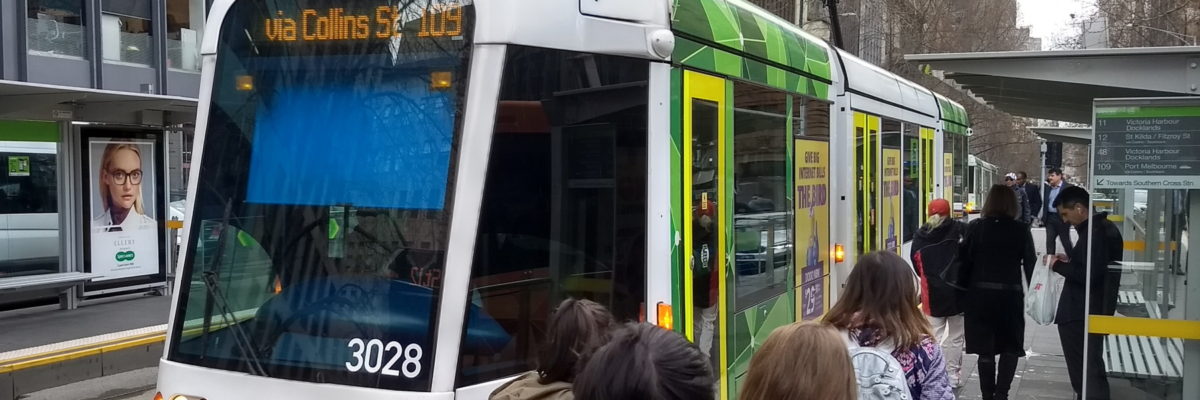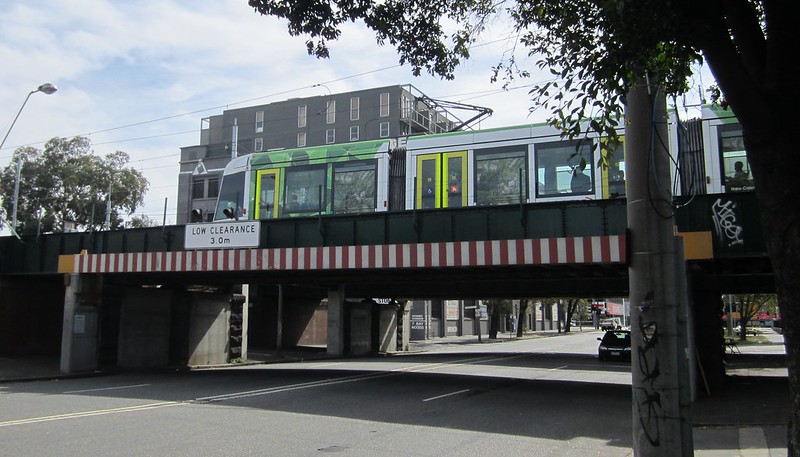I was pondering the speeds of trams on different parts of the network.
A key determinant is the type of route: separation from motor vehicles, and priority at intersections.
Route 109 has a good range of different sections, so here’s a quick comparison of two extremes: AM citybound at 8am vs late-evening (last tram).
| Section | Length | Type | Peak time/speed | Late evening time/speed |
| Light rail: Port Melbourne to Clarendon Street | 2.8 km | Light rail, complete separation and priority | 7 mins 21.4 km/h | 6 mins 28 km/h |
| Melbourne CBD: Clarendon Street to St Vincent’s Plaza | 3.2 km | On-street, dedicated lanes, central city | 20 mins 9.6 km/h | 15 mins 12.8 km/h |
| Victoria Parade: St Vincent’s Plaza to Hoddle Street | 1.4 km | Median, separate from traffic, but no traffic light priority | 6 mins 14 km/h | 4 21 km/h |
| Street running: Hoddle Street to Elgar Road | 11.3 km | Mixed traffic | 43 mins 15.8 km/h | 23 mins 29.5 km/h |
| Elgar Road to Station Street | 0.7 km | Median | 2 mins | 1 min |
The above numbers are based simply on the timetable, which may or may not be accurate!
It didn’t seem worth trying to compare the last short Elgar Road to Station Street section, given it’s so short. The timetable rounds everything to the nearest minute, making the speed calculation not very useful.
Some observations on the rest of the route:
The light rail section has barely any trip time variation between peak and evening. The trams have absolute priority here – a completely segregated track, with level crossings to get across roads, thanks to it being a former railway line. The only time differences would be from passenger loadings.
The Melbourne CBD section is very heavy going, despite dedicated tram lanes. Passenger loadings are heavy at most times of day, but especially in peak hours – Yarra Trams says stop dwell times increased by 7% to 14% on Collins Street in peak after introduction of the Free Tram Zone.
Congestion caused by other trams is also a factor, along with waits at traffic lights, especially King Street which for some crazy reason prioritises north-south motor vehicle traffic, meaning most Collins and Bourke Street trams stop there for the lights – there’s no tram stops.
Victoria Parade is a bit faster than the CBD, with the track in the median strip separated from the road, but traffic lights are still an issue. (This section is also quite short, so the numbers here may be misleading.)
The street section from Hoddle Street to Box Hill surprisingly is slightly faster still, even in peak, despite being in mixed traffic.
Late evening along the street section is particularly zippy, with virtually no traffic around and probably few passengers. It’s actually slightly faster than the light rail section, perhaps because there are fewer late night tram passengers compared to around Port Melbourne.
Plus it’s likely that many of the intersection traffic lights along Whitehorse/Cotham Road and Barkers Road/Victoria Street default to giving the tram a green.
But this section also has the highest variation in speeds, with peak hour being about half the speed of late evening – up to 43 minutes to cover just 11.3 km at 8am. In fact it’s slightly slower after 9am, perhaps due to clearways applying only in peak hour.
Room for improvement
These are only rough calculations, based on timetables rather than real performance, but tram speeds can clearly be improved.
CBD traffic lights could be better coordinated so trams don’t have a stop-start trip between tram stops.
Shorter traffic light cycle times are possible at places like King Street, which would also benefit pedestrians.
Edit: a Yarra Trams insider says another critical issue is the effectiveness of tram lanes along Collins Street. Better separation, such as recently added on sections of William Street, may be the key here.
Victoria Parade should be much better than it is. Unlike the CBD where it may be difficult due to so many pedestrians, pre-emptive traffic light priority (give the tram the green where possible) may be the key here.
Traffic light priority would also benefit the street section, though given the peak vs evening difference, peak hour tram lanes (even just in congestion hot spots) may provide more benefits there.
Accessible tram stops can also help speed things up, by making boarding easier – not just for those with mobility difficulties, but for everybody else too, including parents with prams, or travellers with luggage. There’s a severe lack of these on the street-based eastern section of the route between Hoddle Street and most of the way to Box Hill.
Ultimately, faster trams means faster trips, making the tram system more attractive. But it also means better fleet/driver utilisation so more services can be run, helping to cut crowding.
The solutions are available – what’s missing is government action to prioritise moving people through the inner-city instead of moving cars.



8 replies on “Comparing tram speeds”
Thanks Daniel – important points. What you’ve found here is consistent with my own observations for the north-south trams to Brunswick. Namely that in the AM and PM peaks, trams are actually faster in the mixed-traffic sections than where they have segregated ROW but no traffic light priority. The public transport system almost literally burns cash on inefficient operations due to neglect in the design of the traffic management system.
Thanks for demonstrating what most tram users sadly experience every day.
At 9 km/hr, a tram ride in the city is barely faster than a quick walk. Walking is free, but so is the tram ride.
There are many parts of the system which have gotten slower over the years due to more cars, a lot more of the routes need to be separated from traffic, given lights priority, area congestion charging, street parking relocation, or run times will continue to degrade even further. Chapel street for example; decades ago it used to have three full time services running along it (77,78,79), never needed to wait long for a tram and the journeys were quick, but as the street became more congested trips took longer and eventually services were scaled back to one, which now crawls along, and ridership has dropped as a result. Often quicker to walk.
But people have been saying all this for years, and government after government does nothing, it’s like the end of the tram line extensions which only need to go a few hundred metres more to connect with the the metro – it never gets done. It’s so frustrating that all of these simple measures to improve the service never happen despite all the while the city population keeps growing and the pressure on the transport system keeps increasing
@Shayne, applying the same calculation to route 78 along Chapel/Church St: AM peak northbound 6.8km in 38 minutes = 10.7 km/h. Late evening 22 minutes = 18.5 km/h
There is tram priority in Victoria Parade but as you clarified, there isn’t advance detection, and this is what is needed for trams all over Melbourne. Vicroads and PTV have the knowledge. All that is needed is political will, IE money. But then Vicroads even when funded has hardly exalted itself with its Toorak Road and High Street in the City of Stonnington projects. A total waste of a lot of money, as was the green car wave in Canterbury Road, somewhere near Forest Hill.
For those who don’t know, the Toorak Road tram only direction signs and road lighting are completely ignored by motorists, as is the inbound part dedicated morning peak tram lane in High Street. But it doesn’t matter that they are ignored as peak tram travel in said two streets have parking clearways and cars seldom delay trams. The green wave in Canterbury Road depended on drivers not speeding and not tailgating. A total fail as the experiment failed to take into account the way people drive.
Hundreds of thousands of dollars wasted.
Chapel St between Dandenong Rd and Malvern Rd is an obvious location for an Acland St-style pedestrian mall but after the reaction to Prahran Square, I wouldn’t hold my breath for a while unfortunately.
@Nick, it’d be interesting to do traffic modelling on a Toronto King Street type solution, that is you don’t ban cars, but you don’t let them drive north-south through intersections – you make them turn off. So you remove the through traffic, which accounts for some percentage of the total number of vehicles/delays.
As noted, most tram drivers usually floor it along the quiet half of the 109 (Kew-Box Hill), although flooring it in a wobbly old Citadis means all of 60 km/h, unlike the high floor trams (Z3/A/B2) which are seemingly only limited to how heavy the driver’s right foot is (the City Circle Ws on the other hand were all modified in the early 2000s to add a speed limiter because they were too hard to stop due to having near-useless brakes, which were only partly rectified by fitting emergency brakes (aka track brakes) – prior to that they too could get up to some good speed).
The biggest problem in Melbourne is the timing of traffic lights, and the almost complete lack of hook turns outside the CBD. Given that the vast majority of long waits in the suburban areas are attributed to being stuck behind a car sitting on the tram tracks with its right indicator on, this should be the first thing done in order to improve tram punctuality – if hook turns were enforced around *all* major intersections with trams it would do a world of good.
There is absolutely no reason whatsoever to have waits of well over a minute (if not two minutes) between traffic light cycles. If you watch tressteleg1’s videos on YouTube it speaks for itself when you see how many times a video has been cut at traffic lights, with a message showing how many seconds were wasted (or “out”) sitting at the lights waiting for endless bumper to bumper traffic to stop ploughing through the intersection like it’s a freeway. Another YouTube video (by Schony747), which is not cut, shows an outbound 109a (Box Hill via Bridge Rd, which basically means it’s following route 48 from Parliament all the way to QPO), in its own segregated tram lane, stuck at Punt Rd for over 90 seconds – the video might be from 2014 but I highly doubt the light timing has changed (also note how the traffic lights were programmed to go red as soon as the tram entered the safety zone). The same tram then gets stuck two minutes later at Church St for another 60-80 seconds because, despite having tram lines on both main intersecting roads (the 78 on Church St and 48/75/109a on Bridge Rd), there are no hook turns and of course a car (or a ute in this case) has to stop on the tram tracks in order to turn right, blocking the tram which had a green light the whole time. Same again at Barkers Rd (Kew Depot), the lights change as programmed (tram had to stop anyway) and the tram cops another red for a whopping 96 seconds.
Speaking of the 109 and Citadis trams, whatever happened to the infamous 3011? The Citadis fleet (C1s, not sure about the five C2 Bumblebees) are supposedly in the middle of being refurbished so it would be a waste if it wasn’t being repaired at the same time. The damage to 3011 didn’t look much worse than the B2 which was t-boned by a truck at Royal Park a few years ago.